
| SEARCH |
| UVM A TO Z |
| WHITE PAGES |
| UVM HOME |

Students launch into life at UVM
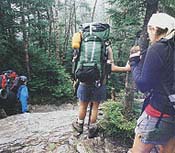 They started their journeys from as close as Winooski and as far
as California. Now they are gathered together in the Billings
Center, preparing to embark on an expedition with strangers. The
tone is serious and focused, voices tight with uncertainty rise
to the vaulted ceiling. The potential for chaos is controlled
by a variety of lists, some of them written, some simply part
of the unspoken code that runs between people of the same age.
Tevas, khaki shorts, sneakers, baseball caps, shell and twine
necklaces, t-shirts, ponytails, and pants with zip-off legs are
definitely on the list. As are piles of gear, mounds of dehydrated
food, crates of granola bars, bags of tortillas, Ziplocs, Nalgene
water bottles, sleeping bags, tarps, Therma-rests, polypropylene,
fleece, wool socks, and hiking boots tied together by their laces.
They started their journeys from as close as Winooski and as far
as California. Now they are gathered together in the Billings
Center, preparing to embark on an expedition with strangers. The
tone is serious and focused, voices tight with uncertainty rise
to the vaulted ceiling. The potential for chaos is controlled
by a variety of lists, some of them written, some simply part
of the unspoken code that runs between people of the same age.
Tevas, khaki shorts, sneakers, baseball caps, shell and twine
necklaces, t-shirts, ponytails, and pants with zip-off legs are
definitely on the list. As are piles of gear, mounds of dehydrated
food, crates of granola bars, bags of tortillas, Ziplocs, Nalgene
water bottles, sleeping bags, tarps, Therma-rests, polypropylene,
fleece, wool socks, and hiking boots tied together by their laces.
 Things that are on the official no-no list include hair dryers,
curling irons, electronic devices, fireworks, and drugs. Also
apparent by their absence are cigarettes, make-up, hairdos, jewelry,
miniskirts, platform shoes. Parents are few and far between, most
having been sent on their way by “kids” ready to take their first
steps into college life. But these steps are not going to be into
a dorm or a classroom. For this group of about 150 students, their
feet are about to put them on the side of a mountain, onto Lake
Champlain, cruising the back roads on a bike, or into a gutted
house with a hammer in hand. It’s the first day of TREK, UVM’s
multi-day/full-immersion orientation for incoming students.
Things that are on the official no-no list include hair dryers,
curling irons, electronic devices, fireworks, and drugs. Also
apparent by their absence are cigarettes, make-up, hairdos, jewelry,
miniskirts, platform shoes. Parents are few and far between, most
having been sent on their way by “kids” ready to take their first
steps into college life. But these steps are not going to be into
a dorm or a classroom. For this group of about 150 students, their
feet are about to put them on the side of a mountain, onto Lake
Champlain, cruising the back roads on a bike, or into a gutted
house with a hammer in hand. It’s the first day of TREK, UVM’s
multi-day/full-immersion orientation for incoming students.
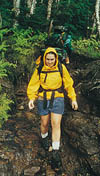 TREK has been in existence for almost a quarter century, introducing
students from around the country to UVM by taking them on an outing
into the world that lies just beyond campus. TREK participants
spend their first five days at college with a group of about ten
other students, either hiking, biking, kayaking, attending seminars
and discussions on leadership issues, working on a Habitat for
Humanity home, or building bridges for the Catamount Trail Association.
In all cases, they live, cook, eat, and work together.
TREK has been in existence for almost a quarter century, introducing
students from around the country to UVM by taking them on an outing
into the world that lies just beyond campus. TREK participants
spend their first five days at college with a group of about ten
other students, either hiking, biking, kayaking, attending seminars
and discussions on leadership issues, working on a Habitat for
Humanity home, or building bridges for the Catamount Trail Association.
In all cases, they live, cook, eat, and work together.
 John Abbott, assistant director for outdoor programs in the Department
of Student Life, describes how the experience typically affects
students: “It opens people’s horizons, connects them to the larger
community, eases their transition to college life, allows them
to start school knowing people, and helps them take a big step
in their maturity level.” Plus, it’s a whole lot of fun.
John Abbott, assistant director for outdoor programs in the Department
of Student Life, describes how the experience typically affects
students: “It opens people’s horizons, connects them to the larger
community, eases their transition to college life, allows them
to start school knowing people, and helps them take a big step
in their maturity level.” Plus, it’s a whole lot of fun.
A few parents linger outside Billings, taking some extra moments to watch the proceedings and say goodbye. They express similar hopes for what a TREK week will accomplish. “Freshman adjustment is hard enough,” Diane Garso of Lake Placid, New York says. “This will give him a head start towards next week.” Ellen Coyne of Washington, D.C. concurs, adding, “I think it will instantly make them feel a part of the community and will add to their sense of well-being and belonging.”
 For the students themselves, getting to know some new people and
having fun are clearly the primary reasons for being here. Andrew
O’Laughlin of Farmington Hills, Michigan loves the outdoors and
wants to become familiar with the geography of the state where
he plans to spend the next four years. Adam Norlander, from East
Greenbush, New York spent his summer leading friends on hikes
in the Adirondacks and it seems natural for him to extend his
love of the mountains to Vermont’s Greens. Will Thomas of Boise,
Idaho is familiar with Habitat for Humanity through his parents’
involvement. He joined TREK’s community service week because he
likes “helping out people in need. Plus it’s fun. Work doesn’t
have to be just work when you get together with cool people.”
For the students themselves, getting to know some new people and
having fun are clearly the primary reasons for being here. Andrew
O’Laughlin of Farmington Hills, Michigan loves the outdoors and
wants to become familiar with the geography of the state where
he plans to spend the next four years. Adam Norlander, from East
Greenbush, New York spent his summer leading friends on hikes
in the Adirondacks and it seems natural for him to extend his
love of the mountains to Vermont’s Greens. Will Thomas of Boise,
Idaho is familiar with Habitat for Humanity through his parents’
involvement. He joined TREK’s community service week because he
likes “helping out people in need. Plus it’s fun. Work doesn’t
have to be just work when you get together with cool people.”
The TREK week starts on a playful note. Each group is led by a team of older students, many of whom are former “Trekkies” themselves. After rousing introductions that reveal deep bonds of affection between the leaders, the students gather on the Green for a series of games. In one, each group of about ten new students and their leaders devises a call for itself. Then everyone crushes together, closes their eyes, and tries to find the others in their group with their call. They oink, quack, squeal, and scream like monkeys. Slowly, deliberately, without opening their eyes, individuals find each other, link arms, and sort themselves back into teams, the search for a similar self completed through the intimacy of connection. This year’s TREK is on its way.
 Each trek group has a name, and this one happens to be the “Grubby
Little Monkeys.” The Monkeys pile out of a yellow school bus,
onto a quiet corner in Jonesville. After an al fresco lunch along
the side of the Winooski River, they collect their packs, change
their sandals for hiking boots, and start up a dirt road to the
trailhead. The day began cool and damp, but the sun is brightening
the afternoon haze, and after the first fifteen minutes of hiking,
there are requests to stop so one woman can change from baggy,
bell-bottom jeans into shorts, and for others to unstrap their
water bottles for a quick sip or two. For a while, conversation
is sparse. “Be careful when you get here,” Colleen O’Brien, a
leader from Winooski, calls back. “The rocks are wet and will
be slippery.” The trail opens up out of dense trees into a clearing
of wildflowers, blackberry vines, and grasses. Everyone pauses
to get another drink and look out over the landscape of rolling
hills and twisting river. “Ah,” says Andrew O’Laughlin. “This
is just what I was looking for.”
Each trek group has a name, and this one happens to be the “Grubby
Little Monkeys.” The Monkeys pile out of a yellow school bus,
onto a quiet corner in Jonesville. After an al fresco lunch along
the side of the Winooski River, they collect their packs, change
their sandals for hiking boots, and start up a dirt road to the
trailhead. The day began cool and damp, but the sun is brightening
the afternoon haze, and after the first fifteen minutes of hiking,
there are requests to stop so one woman can change from baggy,
bell-bottom jeans into shorts, and for others to unstrap their
water bottles for a quick sip or two. For a while, conversation
is sparse. “Be careful when you get here,” Colleen O’Brien, a
leader from Winooski, calls back. “The rocks are wet and will
be slippery.” The trail opens up out of dense trees into a clearing
of wildflowers, blackberry vines, and grasses. Everyone pauses
to get another drink and look out over the landscape of rolling
hills and twisting river. “Ah,” says Andrew O’Laughlin. “This
is just what I was looking for.”
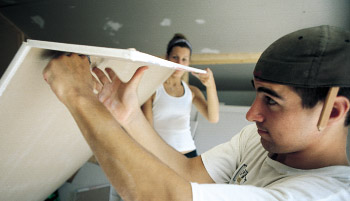 The conversation picks up as the trail turns back into the woods,
and everyone carefully picks their way over slick rocks, through
patches of mud and around roots worn smooth from the many other
feet that have passed this way. As with any group of people getting
to know one another, the questions are many. Where are you from?
What do you like to do? Are you a skier or a snowboarder? Which
mountain should I get a pass for? Where are we going? Where will
we end up? Is the trail going to be this difficult the whole way?
How long is tomorrow’s hike? Is that dorm any good? Can I switch?
Weren’t you in the School of Natural Resources orientation too?
Did you ever find Higher Ground for that concert? Have you heard
that CD? Is that professor any good? Can we take a water break?
The conversation picks up as the trail turns back into the woods,
and everyone carefully picks their way over slick rocks, through
patches of mud and around roots worn smooth from the many other
feet that have passed this way. As with any group of people getting
to know one another, the questions are many. Where are you from?
What do you like to do? Are you a skier or a snowboarder? Which
mountain should I get a pass for? Where are we going? Where will
we end up? Is the trail going to be this difficult the whole way?
How long is tomorrow’s hike? Is that dorm any good? Can I switch?
Weren’t you in the School of Natural Resources orientation too?
Did you ever find Higher Ground for that concert? Have you heard
that CD? Is that professor any good? Can we take a water break?
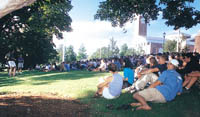 This is the reality version of the introductory game: students
look to find both similarities and differences. Mandy Rude of
Chapel Hill, North Carolina and Kali Shaw from Fort Collins, Colorado
discover a mutual love of country music, sharing favorite lyrics
and concert notes. James Quigly of Cheshire, Connecticut good-naturedly
teases them, “You guys really like that stuff?” But the women
just look at each other and say, “I’m so glad I met you!”
This is the reality version of the introductory game: students
look to find both similarities and differences. Mandy Rude of
Chapel Hill, North Carolina and Kali Shaw from Fort Collins, Colorado
discover a mutual love of country music, sharing favorite lyrics
and concert notes. James Quigly of Cheshire, Connecticut good-naturedly
teases them, “You guys really like that stuff?” But the women
just look at each other and say, “I’m so glad I met you!”
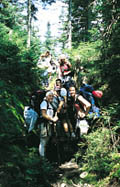 Later, at the campsite set under trees and alongside a small stream,
food is unpacked, firewood gathered, and a comfortable banter
sets in, as does laughter and coaching between all the students.
Leader Matt Spencer, or “Spency” as he is called, shows the group
how to put up a tarp shelter and tie knots both beautiful and
useful. But he gives perhaps the best advice later when, after
everyone has shared his or her choice of major, he says, “It’s
okay to change your mind. You don’t have to stay with the stuff
you’ve chosen already.”
Later, at the campsite set under trees and alongside a small stream,
food is unpacked, firewood gathered, and a comfortable banter
sets in, as does laughter and coaching between all the students.
Leader Matt Spencer, or “Spency” as he is called, shows the group
how to put up a tarp shelter and tie knots both beautiful and
useful. But he gives perhaps the best advice later when, after
everyone has shared his or her choice of major, he says, “It’s
okay to change your mind. You don’t have to stay with the stuff
you’ve chosen already.”
Jen Rock of Baltimore, Maryland shows the others how to build a fire by creating a teepee of sticks, experience apparently gained by attendance at many multi-day music festivals. Andrew takes over the care and feeding of the campfire and points out another stick configuration that also works well. Kali wants to know where to get an absentee ballot. Virtually everyone has already decided on Gore, mostly because of his pro-environment stance, but Jen throws in a few good words about Ralph Nader, and Spency assures everyone that there will be a table to register to vote at the regular orientation. Mandy explains the finer points of a game involving marshmallows. Casey Wilson of Strafford, Vermont tells everyone what it was like to live for a year alone in Wyoming, skiing and working odd jobs, and Jillian Riley of Boxford, Massachusetts talks about two of the Bhutanese princesses who attended school with her. Everyone readily offers help when the chores of the week are listed. Pleases and thank yous are easily and frequently passed around, as is the GORP and the dinner of sautéed vegetables and rice.
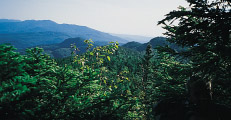 After the food is eaten and everything potentially edible hauled
up into a tree out of the reach of bears, the campsite descends
into the deep quiet of a dozen people staring into the fire, in
the company of each other and their own thoughts. Perhaps the
anxieties that had concerned their parents are starting to surface.
But it is more likely that everyone is simply tired. They have
spent much of the last week saying goodbye to friends, staying
up late at going-away parties, traveling, getting gear together,
hiking all afternoon, and now simply need rest. Which they get,
like sardines packed in their own sleeping bags, stretched out
under a bright blue tarp that sings with raindrops for an hour
or so in the middle of the night.
After the food is eaten and everything potentially edible hauled
up into a tree out of the reach of bears, the campsite descends
into the deep quiet of a dozen people staring into the fire, in
the company of each other and their own thoughts. Perhaps the
anxieties that had concerned their parents are starting to surface.
But it is more likely that everyone is simply tired. They have
spent much of the last week saying goodbye to friends, staying
up late at going-away parties, traveling, getting gear together,
hiking all afternoon, and now simply need rest. Which they get,
like sardines packed in their own sleeping bags, stretched out
under a bright blue tarp that sings with raindrops for an hour
or so in the middle of the night.
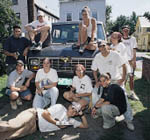 Back in burlington, another group of TREK students is also engaged
in the tasks of day-to-day closeness with strangers, cooking,
camping, and getting to know one another. But their campsite is
the hard floor in the basement of St. Paul’s Cathedral rather
than the decayed leaves on the side of Mt. Mansfield, and their
days are spent hauling sheets of drywall, not bulging backpacks.
This group is helping Habitat for Humanity renovate an Old North
End home for a Burlington family of four.
Back in burlington, another group of TREK students is also engaged
in the tasks of day-to-day closeness with strangers, cooking,
camping, and getting to know one another. But their campsite is
the hard floor in the basement of St. Paul’s Cathedral rather
than the decayed leaves on the side of Mt. Mansfield, and their
days are spent hauling sheets of drywall, not bulging backpacks.
This group is helping Habitat for Humanity renovate an Old North
End home for a Burlington family of four.
These dozen students spend their days in a dance of work in a tight upstairs space that is quickly being transformed into two bedrooms and a bath for the family’s children. Hammers, saws, utility knives, large slabs of sheet rock and brand new tool belts are their props. Calls for a T-square or an extra hand, the slap of metal tapes sliding back into place, requests for jotted down measurements, and the constant undercurrent of laughter are their accompaniment.
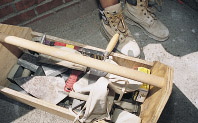 Andrew Feldman, who heads community service projects for the university’s
Department of Student Life, points out that this project puts
the students in touch with the town and the larger Burlington
community beyond the classrooms and residence halls. In addition,
he says that students who participate in TREK are much more likely
to participate in extra-curricular activities throughout the rest
of their college years.
Andrew Feldman, who heads community service projects for the university’s
Department of Student Life, points out that this project puts
the students in touch with the town and the larger Burlington
community beyond the classrooms and residence halls. In addition,
he says that students who participate in TREK are much more likely
to participate in extra-curricular activities throughout the rest
of their college years.
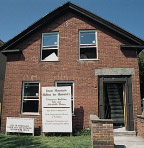 The upper classmen are helpful role models for the value of ongoing
community service. Audrey Levin, one of the leaders for this group,
has been involved in several Alternative Spring Break programs,
including working in a homeless shelter and tutoring inner-city
kids. She says that doing something “meaningful” is important
to her, but she also enjoys the opportunity to help new students
get comfortable in Burlington, to see “all the different personalities”
coming together, and to work in a “positive, upbeat, stress-free
environment” with her peers for a week.
The upper classmen are helpful role models for the value of ongoing
community service. Audrey Levin, one of the leaders for this group,
has been involved in several Alternative Spring Break programs,
including working in a homeless shelter and tutoring inner-city
kids. She says that doing something “meaningful” is important
to her, but she also enjoys the opportunity to help new students
get comfortable in Burlington, to see “all the different personalities”
coming together, and to work in a “positive, upbeat, stress-free
environment” with her peers for a week.
New student Will Thomas agrees. He says that his home state of Idaho provided him with plenty of opportunity for outdoor activities, so he chose the Habitat project as “a good way to become part of the community, rather than just thrown into the college environment and just getting to know someone in passing.” He appreciates the “different attitudes and lifestyles coming together” for the common cause of helping others.
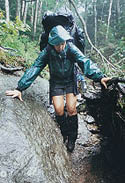 While Habitat for Humanity uses a wide range of volunteer groups,
John Owen, president of the Green Mountain Chapter, knows that
the UVM students bring something unique. “They have so much energy
and enthusiasm,” he says. “They’re willing to plunge in and do
anything.”
While Habitat for Humanity uses a wide range of volunteer groups,
John Owen, president of the Green Mountain Chapter, knows that
the UVM students bring something unique. “They have so much energy
and enthusiasm,” he says. “They’re willing to plunge in and do
anything.”
The camaraderie that develops within just a few days of working and living together is obvious. Help is easily asked for and given. Those with more experience guide those with less. Encouragement is shouted from room to room and from the second story into the backyard. Many corners are bashed, many nails are bent, the measurements are sometimes inexact, and cuts often need to be re-trimmed. But as one student cuts through what appears to be a solid wall of sheetrock to reveal a window opening, sunlight pours in, and it’s easy to imagine this same space with a fresh coat of paint and a child playing in a room finally all his own.
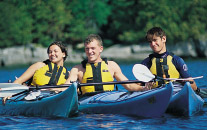 The trek week is almost at a close. Students have come full circle:
they started their first day at Billings, then spread out to the
Adirondacks, Mt. Mansfield, Lake Champlain, or just down the street
in Burlington, and are now back at Billings, enjoying a barbecue
after a quick stop in the dorms for a shower. They move out, once
again, onto the University Green, but now all traces of nervousness
are gone. They are a tight-knit group made of even more tightly
knit teams, individuals woven together by a week of shared experiences.
Through stories and skits that each team presents, they tell each
other tales of their travels, of adventures both large and small,
of strange food, deep muck, bad weather, journals passed around
the campfire, lost cell phones, missteps and bad jokes.
The trek week is almost at a close. Students have come full circle:
they started their first day at Billings, then spread out to the
Adirondacks, Mt. Mansfield, Lake Champlain, or just down the street
in Burlington, and are now back at Billings, enjoying a barbecue
after a quick stop in the dorms for a shower. They move out, once
again, onto the University Green, but now all traces of nervousness
are gone. They are a tight-knit group made of even more tightly
knit teams, individuals woven together by a week of shared experiences.
Through stories and skits that each team presents, they tell each
other tales of their travels, of adventures both large and small,
of strange food, deep muck, bad weather, journals passed around
the campfire, lost cell phones, missteps and bad jokes.
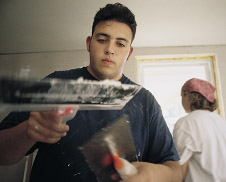 When the Habitat for Humanity team stands, they sing a simple
refrain that says much about the straightforward value of the
week’s work: “We build houses, yes we do. We build houses, yes
we do. We build houses, what do you do?”
When the Habitat for Humanity team stands, they sing a simple
refrain that says much about the straightforward value of the
week’s work: “We build houses, yes we do. We build houses, yes
we do. We build houses, what do you do?”
But perhaps the most ringing endorsement of TREK comes not just in the friendships made, but in the large number of students who now want to share what they’ve learned by becoming leaders themselves. James, Adam, and Andrew, three young men who hadn’t even met each other five days earlier, stand side by side on the sloping lawn of the Green and speak of their plans to be active members of the Outing Club and future TREK leaders. They’re asked if they expect to be standing in the same place with each other four years from now. Without hesitation, they all nod simultaneously. “Yep. Definitely. That’s the plan,” says one, speaking for them all. VQ
Laurel Saville is a freelance writer living in Jericho, Vermont. An avid outdoorsperson, she welcomed the opportunity to join the Trekkies on the trail.